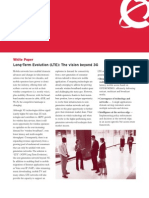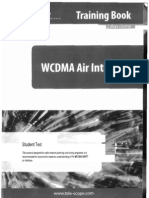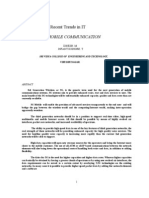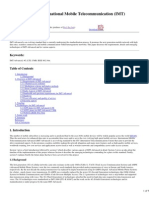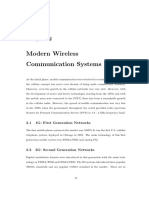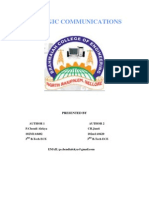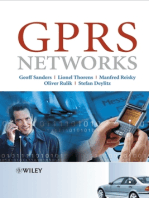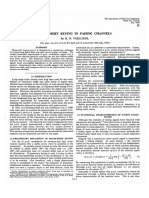Telecommunication
Telecommunication
Uploaded by
arvindranganathanCopyright:
Available Formats
Telecommunication
Telecommunication
Uploaded by
arvindranganathanOriginal Description:
Original Title
Copyright
Available Formats
Share this document
Did you find this document useful?
Is this content inappropriate?
Copyright:
Available Formats
Telecommunication
Telecommunication
Uploaded by
arvindranganathanCopyright:
Available Formats
ous"By
tlle
El:t.
"v. fin/riilire\"flilh--dO~~cnv
ot-,
tt,~..1el>...-i~ill>'A<
- I:>'-.r"~
h.....~Q)
.... O~
v-~
ce,
(-
.~ offers higher capacity and 3G enhanced network functionalities
1,-
.d
whole of telecom industry is in a celebration .n mood on two counts - first on -Us the feat of India achieving .ra 500 million telephones well ~e ahead ofthe target in Novemm- ber 2009, second on the timeny ly introduction of 3G mobile 1.S a service in the country. Consumer's will have another benefit soon when the Mobile Number Portability (MNP) is nas introduced to enable them to i as switch over to any service .ajor provider without the change J;sts of their number at a very 'ers, nominal charge. 3G is a term coined by globand al cellular community to inver" dicate the next generation of uses mobile service capabilities 'ons (higher capacity and enopes hanced network functionali.y as ties) that allow advanced -ro- services and applications in,the cluding Multimedia.3G in the ~ \se mobile network. It is a basket .st" of good services and facilities -n- I for the customers.
i'th .as
I The
CRITERIA EXPECTED: A good mobile broadband system must fulfil several criteria. - PHOTO: AP
called 3G Partnership Project analyzing and releasing specifications for future wireless networks. The radio standard pre'scribed by 3GPP is based on WCDMA, using a bandwidth of 5 MHz with 3.84 Mcps on asynchronous mode and CDMA2000' using the bandwidth of 1.25 MHz with 1.2288 Mcps on Synchronous mode. M per ITU. (International Telecommunication Union) standard India is allotting 2x5 MHz of spectrum in 2.1 GHz frequency band to the would be successful bidders in the auction to be held shortly. 3G is not the ultimate to meet the increased demand for mobile broadband users, as there are some hidden barriers of poor propagation characteristics like unreduced latency and difficulty encountered in deep penetration of manmade structures and poor spectral efficiency. er for circuit switching for voice calls. 3GPP's next release has gone to address the above deficiencies in a better method. Data usage with multimedia capability in the mobile broadband access is the demand the operators are facing now. By 20lO we expect there to be over 600 million mobile, broadband subscribers, rising to 900 million by 2012 and the vast majority, will be served by advanced networks such as HSPA' (High Speed Packet Access) and LTE (Long Time Evolution). A good mobile broadband system must fulfil certain criteria, including high data rate, high capacity, low cost per bit, low latency, good quality of service (QoS), and good coverage. Several techniques can be used to meet these criteria in a wireless system. 3GPP Release 7 introduced HSPA (High Speed Packet Access) evolution which supports MIMO (Multiple Input.and Multiple Output) antenna system, to further boost the peak data rate and capacity. HSPA evo-
vur'jes taren"oel nich j is {ere .ial for sevwo ge.ein
Dominant facilities
Dominant among them are improved system capacity, backward compatibility with 2G systems, multimedia support and high speed packet data services to the extend of 2 Mbps in stationary environments. Packet switched data service; harmonized standards and integrated network operation are new features which differentiate the 3G service from2G. The new facilities likely to be enjoyed by 3G mobile users include video call, call ring back video, yellow pages, video SMS, real time video communication, mobile video conferencing and video monitoring in health and safety applications. 3 GPP is a technical group
.ages
,nes pro_ are why , ulti-
Circuit switching
Moreover the data speed in moving vehicles could not be improved beyond 144/384 kbps. The operators have still to maintain equipment to cat-
.I'IIAN
.i.org
lution supports data rates of up to 42Mbps in the downlink and n.5Mbps in the uplink. LTE (long-term evolution), currently being specified by 3GPP for Release 8, introduces OFDM/OFDMA(Orthogonal Frequency Division Multiple Access) in the downlink and single-carrier FDMA (SC-FDMA) in the uplink. Goal of LTE is to provide 300Mbps Data rate in Down Link, provide greater than 75 Mb Data rate in Uplink, to . minimize latency to less than 5 ms and to reduce cost in network deployment by using channel bandwidths of approximately1.25MHz up to at least 20MHz The HSPA, LT'E and Mobile WiMAX technologies have been designed for highspeed packet data services. They feature similar technology enablers, including dynamic scheduling, link adaptation, H-ARQ with soft combining, multiple-level QoS, and advanced antenna systems. . These can be built using existing GSM radio network sites and is a software upgrade of installed WCDMA networks. When usedtogether with dual-mode terminals, these factors ensure nation.wide coverage for voice (GSMjWCDMA) and data (HSPA/EDGE); Thanks to its heritage, they give operators a single network for multiple services with a sound business case built on revenues from vari,~ ous features as well as un- . matched economies of scale that benefit all players in the ecosystem. A.GANESAN Former Dy. General Manager BSNL, Chennai
CH.0'1
You might also like
- Concise Guide to OTN optical transport networksFrom EverandConcise Guide to OTN optical transport networksRating: 4 out of 5 stars4/5 (2)
- Channel Management (5G RAN6.1 - Draft A)Document331 pagesChannel Management (5G RAN6.1 - Draft A)VVL100% (1)
- UMTS To LTE Migration White PaperDocument18 pagesUMTS To LTE Migration White PaperMaria LunaNo ratings yet
- What Is ISO 17712Document9 pagesWhat Is ISO 17712arvindranganathanNo ratings yet
- 2020 ECM226A Lab 1-Laboratory Report-TemplateDocument14 pages2020 ECM226A Lab 1-Laboratory Report-TemplateThembelihle HadebeNo ratings yet
- Topic-1-Notes On 4GDocument4 pagesTopic-1-Notes On 4GfazfemtqeNo ratings yet
- Seminar On: Team MembersDocument18 pagesSeminar On: Team MembersAmit SrivastavaNo ratings yet
- Long-Term Evolution (LTE) : The Vision Beyond 3G: White PaperDocument6 pagesLong-Term Evolution (LTE) : The Vision Beyond 3G: White PaperSenthilathiban ThevarasaNo ratings yet
- EDGE: Enhanced Data Rates For GSM EvolutionDocument38 pagesEDGE: Enhanced Data Rates For GSM EvolutionShebin.A.Khalam100% (1)
- 2020 Vision For LTEDocument6 pages2020 Vision For LTEMouslem BouchamekhNo ratings yet
- C Refers To The Fourth Generation of Cellular Wireless Standards. It Is A Successor ToDocument10 pagesC Refers To The Fourth Generation of Cellular Wireless Standards. It Is A Successor ToPrabahar RamasamyNo ratings yet
- 5g PDFDocument10 pages5g PDFChaudhry Asad IqbalNo ratings yet
- 4g Wireless System FullDocument6 pages4g Wireless System Fullkalbande86No ratings yet
- Fourth Generation Wireless Systems 4G: AbstractDocument10 pagesFourth Generation Wireless Systems 4G: AbstractHarsha CharanreddyNo ratings yet
- WCDMA Air InterfaceDocument54 pagesWCDMA Air InterfaceRookie2No ratings yet
- SVC Dinesh. MDocument10 pagesSVC Dinesh. MJanani SubramanianNo ratings yet
- Millimeter Wave Mobile Communication For 5G CellularDocument24 pagesMillimeter Wave Mobile Communication For 5G CellularVipinkumar HariharanNo ratings yet
- EDGE ReportDocument22 pagesEDGE ReportSowmya SowmyaNo ratings yet
- Bimbo SeminarDocument19 pagesBimbo Seminargolden abidemNo ratings yet
- 3rd Generation Partnership Project: LTE TechnologyDocument21 pages3rd Generation Partnership Project: LTE TechnologypunithNo ratings yet
- 4G Technology: Communication Skills and Soft Skills LabDocument5 pages4G Technology: Communication Skills and Soft Skills LabFermi NivedithaNo ratings yet
- LTE Seminar ReportDocument22 pagesLTE Seminar ReportpunithNo ratings yet
- UMTS - WCDMA TechnologyDocument10 pagesUMTS - WCDMA TechnologysurvivalofthepolyNo ratings yet
- Study of 3G TechnologyDocument7 pagesStudy of 3G TechnologyPooja Bidwai ShirpewarNo ratings yet
- Evolution of Mobile Technology and Business Models: Su-En TanDocument19 pagesEvolution of Mobile Technology and Business Models: Su-En Tanszi1979No ratings yet
- Prasad V. Potluri Siddhardha Institute of Technology: Ifreak 09Document7 pagesPrasad V. Potluri Siddhardha Institute of Technology: Ifreak 09ksgtejaNo ratings yet
- (3G and Wcdma) : Project ReportDocument42 pages(3G and Wcdma) : Project ReportMukesh ManwaniNo ratings yet
- 4G Wireless and International Mobile Telecommunication (IMT) AdvancedDocument9 pages4G Wireless and International Mobile Telecommunication (IMT) AdvancedftbjadeNo ratings yet
- 3g Technology Background4901Document2 pages3g Technology Background4901Ridwanul HaqNo ratings yet
- Modern Wireless Communication Systems: 2.1 1G: First Generation NetworksDocument12 pagesModern Wireless Communication Systems: 2.1 1G: First Generation NetworksImran SikderNo ratings yet
- Generations of Wireless Mobile Systems: Comparison of Channel Capacity For Different Channel TypesDocument2 pagesGenerations of Wireless Mobile Systems: Comparison of Channel Capacity For Different Channel TypesFranch Maverick Arellano LorillaNo ratings yet
- 4G Refers To The Fourth Generation of Cellular Wireless Standards. It Is ADocument16 pages4G Refers To The Fourth Generation of Cellular Wireless Standards. It Is ASagar JayashankarNo ratings yet
- Market Outlook For LTEDocument7 pagesMarket Outlook For LTEfarrukhmohammedNo ratings yet
- Pre Now Post 5GDocument13 pagesPre Now Post 5GAryan KumarNo ratings yet
- 4G Refers To The Fourth Generation of Cellular Wireless Standards. It Is A Successor To 3G and 2G Families ofDocument6 pages4G Refers To The Fourth Generation of Cellular Wireless Standards. It Is A Successor To 3G and 2G Families ofvitchu_123No ratings yet
- A Paper Presentation ON: Department of Information TechnologyDocument10 pagesA Paper Presentation ON: Department of Information TechnologyNethajiBalaramanNo ratings yet
- Index: Sr. No. TopicDocument18 pagesIndex: Sr. No. TopicDinesh ChahalNo ratings yet
- 4G Refers To The Fourth Generation ofDocument12 pages4G Refers To The Fourth Generation ofsahithsindhuNo ratings yet
- High Speed Downlink Packet Access (HSDPA) : Cdma 3GDocument14 pagesHigh Speed Downlink Packet Access (HSDPA) : Cdma 3GAffo AlexNo ratings yet
- White Paper by Usha Communications Technology: General Packet Radio ServiceDocument75 pagesWhite Paper by Usha Communications Technology: General Packet Radio ServicedaliNo ratings yet
- 4g Magic CommunicationDocument9 pages4g Magic CommunicationSurya Pratap DesaiNo ratings yet
- 3G Technol OGY: Presented byDocument14 pages3G Technol OGY: Presented bymiltan_No ratings yet
- Background: 3GPP Long Term Evolution (LTE)Document9 pagesBackground: 3GPP Long Term Evolution (LTE)Madhu RaoNo ratings yet
- Opportunities & Threats For Implementation of 4G Cellular NetworksDocument13 pagesOpportunities & Threats For Implementation of 4G Cellular Networksapi-26871643No ratings yet
- Unit 1 AMCS - Week 1 LectureDocument13 pagesUnit 1 AMCS - Week 1 LectureMANASA P (RA2011004010071)No ratings yet
- 4g Communications BecDocument9 pages4g Communications BecSrini VasuluNo ratings yet
- InTech-Mobility Aspects of Physical Layer in Future Generation Wireless NetworksDocument17 pagesInTech-Mobility Aspects of Physical Layer in Future Generation Wireless NetworksNguyễn Minh DinhNo ratings yet
- Ece3 - 4g Magic CommunicationDocument13 pagesEce3 - 4g Magic Communicationitabassum5No ratings yet
- 3G Cellular Systems PDocument4 pages3G Cellular Systems Pthamilmani12No ratings yet
- 4G Technology: A Paper Presentation OnDocument14 pages4G Technology: A Paper Presentation OnAamna AimanNo ratings yet
- 5g WorldDocument4 pages5g WorldSourav ChandraNo ratings yet
- 4G-Beyond 3G and Wireless Networks: Indira Gandhi National Open University (IGNOU), Delh, IndiaDocument8 pages4G-Beyond 3G and Wireless Networks: Indira Gandhi National Open University (IGNOU), Delh, IndiaChara SukaNo ratings yet
- 3G Over SatelliteDocument6 pages3G Over Satellitegamer08No ratings yet
- Itu-R Cellular System: - Branded Samsung LTE ModemDocument9 pagesItu-R Cellular System: - Branded Samsung LTE ModemVivek NayeeNo ratings yet
- Mobile Core Network EvolutionDocument2 pagesMobile Core Network EvolutionUdeeptha_Indik_6784100% (1)
- mhdC8Vuv5Ntvq8MUqJCZI9Jo PDFDocument34 pagesmhdC8Vuv5Ntvq8MUqJCZI9Jo PDFAhmed58seribegawanNo ratings yet
- 3G or 3rd Generation Mobile Telecommunications Is A Generation of Standards For Mobile Mobile Telecommunications-2000 (IMT-2000) Specifications by The International TelecommunicationDocument4 pages3G or 3rd Generation Mobile Telecommunications Is A Generation of Standards For Mobile Mobile Telecommunications-2000 (IMT-2000) Specifications by The International TelecommunicationSahil JoshiNo ratings yet
- Report On 3G TechnologyDocument11 pagesReport On 3G TechnologySaransh DeswalNo ratings yet
- The 5G Revolution: How the Next Generation of Wireless Will Change EverythingFrom EverandThe 5G Revolution: How the Next Generation of Wireless Will Change EverythingNo ratings yet
- Modeling and Dimensioning of Mobile Wireless Networks: From GSM to LTEFrom EverandModeling and Dimensioning of Mobile Wireless Networks: From GSM to LTENo ratings yet
- Sentence Types: There Are 3 Types of Sentences. Can You Name Them All?Document10 pagesSentence Types: There Are 3 Types of Sentences. Can You Name Them All?arvindranganathanNo ratings yet
- Seasons of The Year MatchingDocument1 pageSeasons of The Year Matchingarvindranganathan100% (1)
- Seasons Arnolds Apple TreeDocument7 pagesSeasons Arnolds Apple Treearvindranganathan100% (1)
- Instructors GuideDocument55 pagesInstructors GuideskypaulNo ratings yet
- 4 Seasons WheelDocument2 pages4 Seasons WheelarvindranganathanNo ratings yet
- Constellation Work BookDocument15 pagesConstellation Work BookarvindranganathanNo ratings yet
- Planet Sword SearchDocument1 pagePlanet Sword SearcharvindranganathanNo ratings yet
- Outerspace DefinitionsDocument1 pageOuterspace DefinitionsarvindranganathanNo ratings yet
- Ypes of MapsDocument8 pagesYpes of MapsarvindranganathanNo ratings yet
- Thankyou LetterDocument18 pagesThankyou LetterarvindranganathanNo ratings yet
- SatelliteDocument29 pagesSatellitearvindranganathanNo ratings yet
- Speech Communication LecturesDocument45 pagesSpeech Communication LecturesarvindranganathanNo ratings yet
- Road Safety Rules & SlogansDocument4 pagesRoad Safety Rules & SlogansarvindranganathanNo ratings yet
- Paragraph WritingDocument22 pagesParagraph WritingarvindranganathanNo ratings yet
- O Most Holy VirginDocument8 pagesO Most Holy VirginarvindranganathanNo ratings yet
- Articles On NVISDocument5 pagesArticles On NVISMikaelNJonssonNo ratings yet
- Digital Assignment 3Document5 pagesDigital Assignment 3PallaviNo ratings yet
- WiFi-TSN ImplementationDocument5 pagesWiFi-TSN ImplementationDurgesh AggarwalNo ratings yet
- 0120 GNSS DGNSS SB 041Document95 pages0120 GNSS DGNSS SB 041Douglas BemficaNo ratings yet
- Coaxial Cable SpecificationsDocument13 pagesCoaxial Cable SpecificationsDjoko L RadjiNo ratings yet
- Ceragon - 1+1 Resilient Microwave Links - Technical BriefDocument8 pagesCeragon - 1+1 Resilient Microwave Links - Technical BriefzrzahzahNo ratings yet
- JA Meshal Alotaibi: Background of DSB-AMDocument4 pagesJA Meshal Alotaibi: Background of DSB-AMMaharshiGohelNo ratings yet
- Voelcker 1960Document8 pagesVoelcker 1960FAKHRI AhmedNo ratings yet
- Signals and SystemsDocument18 pagesSignals and Systemsthamy_15No ratings yet
- Comparison of LoRaWAN Classes and Their Power ConsumptionDocument6 pagesComparison of LoRaWAN Classes and Their Power Consumptionnaim kamarudinNo ratings yet
- What Is The Use of PCM When There Are ADocument2 pagesWhat Is The Use of PCM When There Are Asamiksha choudharyNo ratings yet
- SatelliteDocument6 pagesSatelliteChristian Emmanuel TolentinoNo ratings yet
- Nokia Siemens Networks Flexi Multiradio Antenna System Datasheet Online 17-03-11 PDFDocument2 pagesNokia Siemens Networks Flexi Multiradio Antenna System Datasheet Online 17-03-11 PDFMukul MandalNo ratings yet
- Data Compression Online MCQ TestDocument6 pagesData Compression Online MCQ TestValar MorghulisNo ratings yet
- Filterbank-Assisted Channel Estimation For Coherent Optical FBMC OQAM SystemDocument7 pagesFilterbank-Assisted Channel Estimation For Coherent Optical FBMC OQAM SystemMuhannad AydiNo ratings yet
- Design of A Dual Band MIMO AntennaDocument20 pagesDesign of A Dual Band MIMO AntennaDaniel DsilvaNo ratings yet
- Ecc4100 SkyphyII Dvb-s2 Transceiver Datasheet 007 LoResDocument4 pagesEcc4100 SkyphyII Dvb-s2 Transceiver Datasheet 007 LoResJackson Dias RochaNo ratings yet
- Realtek RTL2832U: The Mystery Chip at The Heart of RTL-SDRDocument2 pagesRealtek RTL2832U: The Mystery Chip at The Heart of RTL-SDRMoh MohNo ratings yet
- Module 2 Lesson 4: An Improved Ekf: The Error-State Extended KalmanDocument12 pagesModule 2 Lesson 4: An Improved Ekf: The Error-State Extended KalmanMary JusticeNo ratings yet
- Plug GableDocument7 pagesPlug Gablechaidar_lakareNo ratings yet
- Ant A19451505Document2 pagesAnt A19451505FURIVANNo ratings yet
- Product Specifications: 844G80VTA-SXDocument3 pagesProduct Specifications: 844G80VTA-SXfaapctba2913No ratings yet
- RJIL 5G SSCVT Acceptance Report - I-TN-WNDW-ENB-6003 - 1 - 3500Document162 pagesRJIL 5G SSCVT Acceptance Report - I-TN-WNDW-ENB-6003 - 1 - 3500ArulNo ratings yet
- 05ipst247 PDFDocument6 pages05ipst247 PDFAnonymous i8hifn7No ratings yet
- TD-SCDMA Physical Layer Design OverviewDocument7 pagesTD-SCDMA Physical Layer Design OverviewthinksriniNo ratings yet
- Photonic Communications: Intro To Course & To PhotonicsDocument32 pagesPhotonic Communications: Intro To Course & To Photonicsmcclaink06No ratings yet
- Advanced Communication-Lab - Part BDocument16 pagesAdvanced Communication-Lab - Part BPriyanka EcNo ratings yet
- r05320201 Digital Signal ProcessingDocument8 pagesr05320201 Digital Signal ProcessingSri LalithaNo ratings yet








